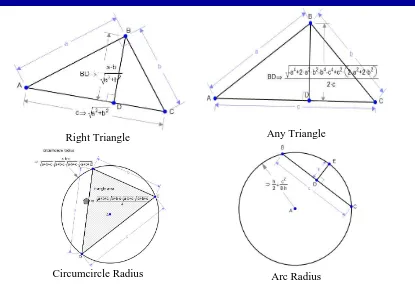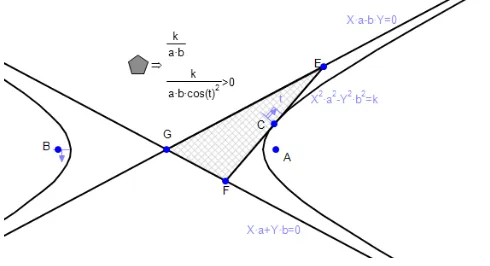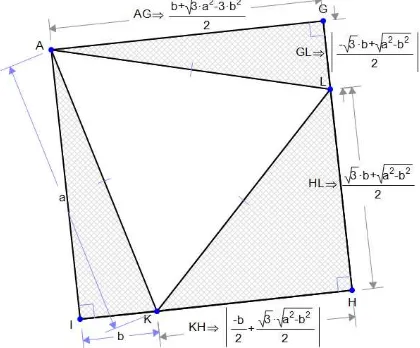E
–
21
Developing Mathematical Discovery Ability
Using Geometry Expression Software
Hedi Budiman Mathematics Education Universitas Suryakancana
Cianjur
hbudiman2011@gmail.com
Abstract
The role of computer technology as a learning media for teaching geometry in the class has started being done. Integration of computer technology in learning can help students to understand the concepts and to improve teaching mathematics in classroom for teacher. Using Interactive Geometry Software (IGS) in the classroom may develop the ability of mathematical thinking, and many provide an opportunity for students to make hypotheses and generalizations. Some of geometry software namely Cabri 2D, Geometers’ Sketchpad, and GeoGebra for teaching geometry in middle and high school students. At the university level, one of the geometry software in the course of plane geometry is geometry expression. This software combines geometry and algebra with a dynamic symbol. Symbolic measurements for quantities such as distances, angles, areas, and equations are automatically computed by the system. The student ability of mathematical discovery will be increasingly developed with geometry expression facilities for exploration, investigation, and interpretation by interplaying between geometry and algebra for solving mathematical problems.
1. Introduction
Mathematical knowledge and skills are steadily gaining importance for everyday life in a lot of countries all around the world. This heightens the importance of making mathematics education accessible to all students and increasing their mathematics proficiency so as to prepare them for life outside school. In order to provide a higher quality education for students, capable teachers are desperately needed, who are willing to implement creative learning environments with technology for the purpose of
maximizing their students’ learning success [1]. Some researchers believed that technology, if correctly used, can enhance teaching and learning. [3] founded from research that student-centered, technology integrated learning environments help to produce students who are better able to think critically, solve problems, collaborate with others, and engage deeply in the learning process.
In the 21st century, technology is an essential tool for learning mathematics and all schools must ensure that all their students have access to technology that influences mathematical thinking and enhance students’ learning [15]. The Computer technology is a powerful and helpful tool in teaching and learning mathematics, in particular in understanding the mathematical concepts [9]. Students can benefit in different ways from technology integration into everyday teaching and learning, with allow teachers to adapt their instruction and teaching methods more effectively to their students’ needs [14] and can potentially engage students of different mathematical skills and levels of understanding with mathematical tasks and activities [11]. By integrating educational tools into their everyday teaching practice, teachers can provide creative opportunities
for supporting students’ learning and fostering the acquisition of mathematical
mathematics than they encountered as students themselves. In this way, teachers would learn about new approaches of teaching with technology and become better prepared for its effective integration into their own teaching practice [13].
The effective use of technology in the mathematics classroom depends on the teacher. Technology is not a panacea. As with any teaching tool, it can be used well or
poorly. Teachers should use technology to enhance their students’ learning
opportunities by selecting or creating mathematical tasks that take advantage of what technology can do efficiency and well in graphing, visualizing, and computing. Using computers and learning how to work with special software definitely is a challenge for teachers, especially, if they have no experience with new technology. Once they have mastered the basic skills necessary to operate software, there is still a long way to go before they actually are able to effectively integrate it into their everyday teaching practice. [13] stated that teachers need to learn how to selectively use software in their classrooms, how to increase the interactivity and flexibility of mathematics learning, and how to improve student achievement by providing new and more effective learning opportunities.
Some of mathematical software created to help students and teachers in mathematics classroom. Teaching and learning geometry in classroom can use this mathematical software. The properties of geometry provide one area where the technology can be used for more learning to explore problems and develop understanding. Among the various reasons research has found for this phenomenon. The software currently in use in classrooms, have value if used to help develop ideas, through play and experimentation, rather than simply as a calculating tool. [19] stated that the appropriate use of dynamic geometry software can enhance mathematics teaching and conceptual development, and enrich visualization, while also laying a foundation for deductive proof. Such technology may help students in their learning processes by enabling them to visualize geometry concepts being studied. Students can explore properties of geometry, enable to examine mathematical ideas on their own, allowing them not to be just consumers of technology but producers of knowledge through technology. Students can be creative, be involved, and can advance their learning as they study geometry. An important consideration is to use technology to develop background knowledge and ways of thinking as well as help students move further in their understanding of core geometry concepts. To maximize the potential of technology, teachers need to understand the how, what and why of teaching with technology. They need experience in considering when technology can most effectively be used.
In Indonesia, although access to new technology is provided in some schools, the process of technology integration into everyday teaching is still very slow, and the full potential of computers and software for mathematics teaching and learning geometry is far from being targeted. The school should be aware of the central role teachers play in
their students’ learning using computer in classroom. Teachers need to be adapted in
order to keep up with the high demands of effectively integrating technology into mathematics teaching. For the students, a focus needs to be on fostering students’ understanding of mathematical concepts and creating more effective learning environments with technology.
they were more successful in discovering new mathematical ideas than when they used static, paper-based diagrams. Discovering a truth has three components. First, there is the independence requirement, which is just that one comes to believe the proposition
concerned by one’s own lights, without reading it or being told. Secondly, there is the
requirement that one comes to believe it in a reliable way. Finally, there is the
requirement that one’s coming to believe it involves no violation of one’s epistemic
state. With other word, discovering a truth is coming to believe it in an independent, reliable, and rational way. Discovery and proof can live side-by-side and allow for the ordinary and the talented to flourish in their own fashion [7].
Discovery is the act of detecting something new, or something old that had been unknown. With reference to science and academic disciplines, discovery is the observation of new phenomena, new actions, or new events and providing new reasoning to explain the knowledge gathered through such observations with previously acquired knowledge from abstract thought and everyday experiences [12]. Some discoveries lead to the invention of objects, processes, or techniques. A discovery may sometimes be based on earlier discoveries, collaborations or ideas, and the process of discovery requires at least the awareness that an existing concept or method can be modified or transformed. However, some discoveries also represent a radical breakthrough in knowledge. Discovery evokes a sense that there is a static, unchanging aspect of mathematics. It emphasizes the objective dimension of mathematics [2].
Mathematical discovery is art of problem solving [17], that is, four basic stages : (a) understanding the problem; (b) devising a plan; (c) carrying out the plan; (d) looking back [16]. Mathematical discovery mainly on the way of thinking, thinking route, focus how to solve problems, how large knowledge, how to find a new proposition to create mathematics. Mathematical discoveries include three main activities: (a) discovering an important (interesting/applicable) concept, open conjecture, theorem, proof or algorithm; (b) revising a previous result, by for instance, the identification of a flaw or the simplification of a proof; (c) deriving a new method, in particular a proof strategy or a construction technique for concepts [4].
2.
Plane Geometry in Geometry Expressions Software
Dynamic Geometry software has been proven over the last twenty years to be a strong facilitator of learning [6]. In education of math, the ability of software making a relationship between geometry and algebra has become an important value in math curriculum [10]. One of InteractiveGeometry Software (IGS) for undergraduate level in the course of plane geometry is geometry expression, which extends the geometry (into the symbol manipulation world of the computer algebra system, Maple, and Matematica).
Right Triangle Any Triangle
Circumcircle Radius Arc Radius
Figure 2.1 A Geometry Expressions Model Showing Symbolic Input and Output.
Geometry Expressions is very helpful to proof theorem. The facilities in operating tools help user for exploration, investigation and interpretation to improve discovery ability in geometry problems. Figure below show that students will have more experiences to practice in proofing.
1) If joining the points at parametric location t and (t+π/2) on an ellipse with the center of the ellipse, the resulting triangle has area half the product of the semi principal axes [18].
Figure 2.2 Parametric Points on an Ellipse
Figure 2.3 Parabola tangent-focus-axis triangle
3) The triangle formed by the tangent and two asymptotes of a hyperbola has constant area. (i.e. independent of t, which specifies the location of the tangent point) [18]
Figure 2.4 Tangent Asymptote Triangle
3. Integrating with Other Software
Success in learning and doing geometry requires a blend of intuition and deduction. Intuition is founded on a wide range of experience of geometric figures and their properties developed both by practical activities and by discussion of their features. The art of deduction is learnt by seeing it in action through a wide variety of examples presented by teacher and text, accompanied by commentary and discussion of what is being stated and why. Alongside this students need abundant opportunities to develop their own arguments by working on tasks tackled individually or in collaboration with peers with guidance from teachers. [5]. The use of computer software with potentially valuable resources that can significantly enhance students' intuition, deduction, motivation and develop understanding to proof theorem, and investigation and discovery ability when used thoughtfully. Some of software can be used in conjunction with other computer programs they are particularly valuable when linked to programs such as Geometry expressions.
from a drawing, however, provides a means of genuine generalization. Both generalization and specialization have their place in the toolbox of techniques used in mathematical discovery [17].
First challenge, on figure below, students can be encouraged to discover formula for perpendicular segments in right triangle. If students try to develop the right triangle with finding the length of perpendicular segment to AB and AC properties (i.e BD, DE, EF, FG, GH), there are arithmetic sequence founded [18]
Figure 2.5 A Geometry Expressions Model Showing Symbolic Input and Output
The segments pattern of the sequence are :
GH
The symbolic generalization reveals a clear pattern, and the nth perpendicular segment in right triangle in above sequence should have length:
n
For the length of perpendicular segment to BC and AC is:
n
Figure 2.6 Circulars in Right Triangle
On figure above, both circular have the radius EF and GH. Geometry expressions generate algebraic expressions of the radius:
2
From the both radius, the formula consist of triangle side, a and b. If investigation the ratio of the radius of these circles, the relationship show:
b theorem: Inscribe an equilateral triangle in a square such that one corner of the triangle is a corner of the square and the other two corners lie on the opposite sides of the square. The theorem states:
The area of the larger right triangle is the sum of the areas of the smaller two. [18]
Figure 2.7 Rectangle Circumscribing an Equilateral Triangle
From the figure above, taking as a starting point to calculate the area of:
AIK =
The equation (2.12) and (2.13) show same result. This proving will encourage students to develop mathematical discovery for others cases.
At what point on the earth’s surface does a perpendicularly suspended rod
appear longest?
We can approach this initially in a routine fashion. In figure 2.8, the earth has radius r. The angle subtended by the rod at point F ( CFG) on the surface of the earth angle θ from the direction of the rod is calculated by Geometry Expressions:
Figure 2.8 Regiomontanus’ Maximum Problem in Geometry Expressions
Copying into Maple, we can differentiate and solve:
> solve (diff(%, theta)=0, theta) :
Figure 2.9 Visualization of the Optimal Solution [21]
4. Conclusion
Using integrated dynamic geometry software in classroom needs to be provided in order to support teachers. To encourage mathematical discovery ability, teachers do not only use a new software tools but also by introducing it to methods of how effectively integrate technology into their teaching practices for student in classroom. Furthermore, teachers need be prepared for the increasing complexity of their teaching environment which definitely creates more challenges for both teachers and students than traditional classroom settings.
Geometry Expressions as integrated dynamic geometry software have facilities to support the experiment. A Symbolic Geometry system such as Geometry Expressions is an effective bridge to encourage student’s mathematical ability in proving and discovering. The software facilities are very helpful for users to explore the problems, to investigate in solving, and to interpret the solution.
The software can be used in conjunction with other computer programs they are particularly valuable when linked to programs such as CAS, Maple and Matematica. The facilities allow complicated problems to be solved through routine application of standard techniques and can be relied upon to perform the manipulations required to generate a solution during discovery process.
References
[1] Adler, J. (2005). Mathematics for Teaching: What is It and Why is It Important That We Talk About It? Pythagoras, 62, 2–11.
[3] Ching, C. C., Basham, J. D. & Planfetti, E. S. (2005). Technology in Education, Technology in Life. In C. Vrasidas & G. V. Glass (Eds.), Current Perspectives on Applied Information Technologies: Preparing Teachers to Teach with Technology (pp. 225-240). Greenwich, CT: Information Age.
[4] Colton, S. (2003).Computational Discovery in Pure Mathematics. Retrieve from http://www.doc.ic.ac.uk/~sgc.
[5] French, D. (2004). Teaching and Learning Geometry: Issues and Methods in Mathematical Education. New York: Continuum.
[6] Gawlick, T. (2002). On Dynamic Geometry Software in The Regular Classroom. Zentrallblatt fur Didaktik der Mathematik, 34 (3), 85-92
[7] Giaquinto, M. (2007). Visual Thinking in Mathematics: An Epistemological Study. New York: Oxford University Press Inc.
[8] González, G. (2009). Adding Technology to Geometry Class Improves Opportunities to Learn. Retrieve from http:// www.illinois.edu.
[9] Güyer, T. (2008) Computer Algebra Systems as The Mathematics Teaching Tool.World Applied Sciences Journal, 3(1), 132-139.
[10]Hohenwarter, M., & Jones, K. (2007). Ways of Linking Geometry and Algebra: The Case of Geogebra, Proceedings of British Society for Research into Learning Mathematics, 27 (3).
[11]Hollebrands, K. F. (2007). The Role of A Dynamic Software Program for Geometry in The Strategies High School Mathematics Students Employ. Journal for Research in Mathematics Education, 38(2):164 - 192.
[12]McAdams, D.,P. (2013). Person : An Integrated New Introduction to Personality Psychology. Content Technologies Inc.
[13]Mously, J., Lambdin, D., and Koc, Y. (2003). Mathematics Teacher Education and Technology. In Bishop, A. J., Clements, M. A., Keitel, C., Kilpatrick, J., and Leung, F. K. S., editors, Second International Handbook of Mathematics Education, pages 395-432. Kluwer Academic Publishers, Dordrecht.
[14]NCTM (2000). Principles and Standards for School Mathematics. Retrieve from http://www.nctm.org/about/content.aspx
[15]NCTM (2008). The Role of Technology in The Teaching and Learning of Mathematics. Retrieve from http://www.nctm.org/about/content.aspx
[16]Polya, G. (1973). How to Solve It: A New Aspect of Mathematical Method. New Jersey: Princeton University Press.
[17]Polya, G. (1981). Mathematical Discovery: On Understanding, Learning, and Teaching Problem Solving. New York: John Wiley & Sons, Inc
[18]Saltire Software. (2013). Geometry Expressions: Draw The figure and Get the Mathematics. Retrieve from http://www.geometryexpressions.com/index.php. [19]Sanders, C.V. (1998). Geometric Constructions: Visualizing and Understanding






![Figure 2.9 Visualization of the Optimal Solution [21]](https://thumb-ap.123doks.com/thumbv2/123dok/1027307.858515/10.595.219.381.89.280/figure-visualization-optimal-solution.webp)